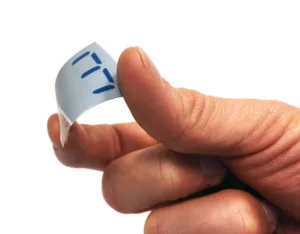The Swedish startup company Rdot Displays has developed a novel reflective display technology that is manufactured with conventional printing processes.
The unique features include ultra-low-power consumption, 100-200 µm thickness, bendability, and low-cost thanks to the efficient printing processes.
Printed Electrochromic Display
The entire display is constructed by only a few organic materials that are printed on top of each other, including a plastic substrate, an electrochromic material, and an electrode for each segment. Additional layers such as graphical overlays, circuits, and barrier layers may be added if required. The electrochromic layer is changing optical state when a voltage is applied. With a typical voltage of 3V, the response time for a small segment is approximately 100 ms. The display is also “semi bistable”, which means that the screen is sustaining the image without any power for an extended period. The bistability period can be modified from a few minutes up to days. Shorter bistability time results in faster switching speeds and vice versa. The energy consumption is dependent on the number of switching cycles, but it is typically in the µW regime. This makes the rdot display one of the most energy-efficient displays on the market.
The technology is currently limited to segment layouts, which is highly suitable for numbers, characters, and symbols of any kind. The standard display color is bright gray in the neutral state (OFF) and dark blue in the powered state (ON).
Target Markets
Rdot Displays are targeting both traditional display markets, such as battery-driven IoT products, electronic shelf labels, and consumer electronics, but also new markets where you have typically not used displays before. Examples are smart packaging and labeling, smart textile, and various interior design applications. “Wherever there is a need for an ultra-low-powered display that should communicate a relatively simple message, such as numbers or characters, the Rdot display is the perfect fit.”.
From Design to Mass Production
Segmented displays may require some custom design work regarding the layout of the segments and the various dimensions. Additional parameters, such as encapsulation requirements, potential color changes, and graphic overlays are also possible. Rdot has a sheet-to-sheet printing production line that makes prototyping and design changes a cost-effective and rapid process. A cost-effective roll-to-roll printing process is used for large-scale manufacturing.
Rdot has evaluation kits for sale on their website (rdotdisplays.com). Factors such as energy consumption, driving conditions, thickness, bend radius, and visual performance are examples of what can be evaluated.

